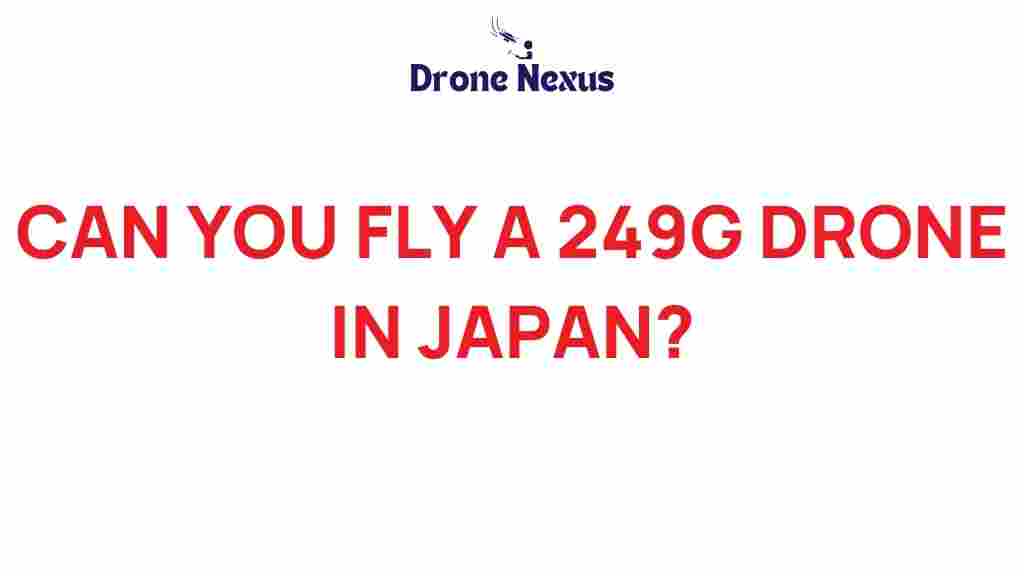Drone Regulations: Can You Fly a 249g Drone in Japan?
With the rapid advancement of technology, drones have become a popular hobby and tool for many individuals worldwide. In Japan, the excitement around flying drones is palpable, but so are the rules surrounding them. If you own a drone that weighs 249 grams or less, you might wonder about the specific regulations that govern its use in Japan. This article will provide an in-depth look into drone regulations in Japan, focusing on 249g drones, the necessary steps for compliance, and helpful tips for safe flying.
Understanding Drone Regulations in Japan
Japan has specific drone regulations that every drone pilot must adhere to. These regulations are designed to ensure safety in the airspace and protect the public. While the rules for flying drones vary depending on the weight and purpose of the drone, a 249g drone falls under a unique category.
Weight Classifications of Drones
In Japan, drones are classified into several weight categories:
- Under 200g
- 200g to 2kg
- 2kg to 25kg
- Over 25kg
A drone that weighs 249g is classified under the 200g to 2kg category, which means it has specific regulations that differ from those for heavier drones. Understanding these classifications is crucial for compliance with Japanese drone regulations.
General Drone Regulations for 249g Drones
For drones weighing 249g, the following regulations generally apply:
- Registration: Drones under 200g do not require registration. However, those between 200g and 2kg must be registered with the Ministry of Land, Infrastructure, Transport and Tourism (MLIT).
- Pilot Certification: While no specific pilot certification is required for flying a drone under 2kg, it is essential to have a basic understanding of drone flying and safety practices.
- Flight Restrictions: Drones must not fly over populated areas, near airports, or in restricted airspace.
- Insurance: While not mandatory, it is highly recommended to have liability insurance in case of accidents.
Steps to Fly a 249g Drone Legally in Japan
If you’re eager to take your 249g drone for a flight in Japan, follow these steps to ensure you’re compliant with local drone regulations.
Step 1: Register Your Drone
Even though the drone weighs less than 250 grams, if it’s within the 200g to 2kg range, you must register it. Here’s how:
- Visit the MLIT website for drone registration.
- Fill out the necessary forms online or download them for manual submission.
- Submit your application along with any required documentation.
- Receive your registration number, which must be displayed on your drone.
Step 2: Familiarize Yourself with Local Laws
Each region in Japan may have specific laws regarding drone use. It’s essential to:
- Check local ordinances and regulations.
- Stay informed about temporary no-fly zones, especially during events or emergencies.
- Consult online resources or local drone clubs for updated information.
Step 3: Conduct a Pre-Flight Inspection
Before taking your drone out, perform a thorough check to ensure it’s in good working order:
- Inspect the battery and ensure it is fully charged.
- Check the propellers for any damage.
- Ensure the camera and other accessories are securely attached.
Step 4: Choose an Appropriate Flight Location
When selecting a flight location, consider:
- Open spaces away from crowded areas.
- Locations that are not near airports or military bases.
- Public parks or designated drone flying areas, if available.
Step 5: Follow Safety Protocols While Flying
While flying your drone, adhere to the following safety protocols:
- Maintain a visual line of sight with your drone at all times.
- Do not fly above 150 meters (492 feet).
- Avoid flying in adverse weather conditions.
- Be respectful of privacy and do not capture images or videos of individuals without their consent.
Troubleshooting Common Issues
Even with careful preparation, you might encounter problems while flying your drone. Here are some common issues and their solutions:
Issue 1: Loss of Signal
If your drone loses connection with the remote, follow these steps:
- Remain calm and do not panic.
- Wait for a few moments; most drones have a return-to-home feature that can help.
- If the drone does not return, use the GPS to locate and retrieve it.
Issue 2: Battery Drain
To avoid unexpected battery drain:
- Always check the battery level before flight.
- Bring extra batteries if you plan to fly for an extended period.
- Consider using a battery monitoring app for real-time updates.
Issue 3: Camera Malfunction
If your drone’s camera isn’t functioning correctly:
- Ensure the camera lens is clean and unobstructed.
- Check for software updates that may resolve the issue.
- Reset the camera settings if necessary.
Conclusion
Flying a 249g drone in Japan can be a thrilling experience, provided you adhere to the established drone regulations. By understanding the rules, registering your drone, and following safety protocols, you can enjoy the freedom of flight while ensuring the safety of yourself and others. Remember to stay updated on any changes in regulations and always prioritize safety during your drone flights. For more information on flying drones in Japan, visit the Japanese Ministry of Land, Infrastructure, Transport and Tourism website.
This article is in the category Safety and created by DroneNexus Team
